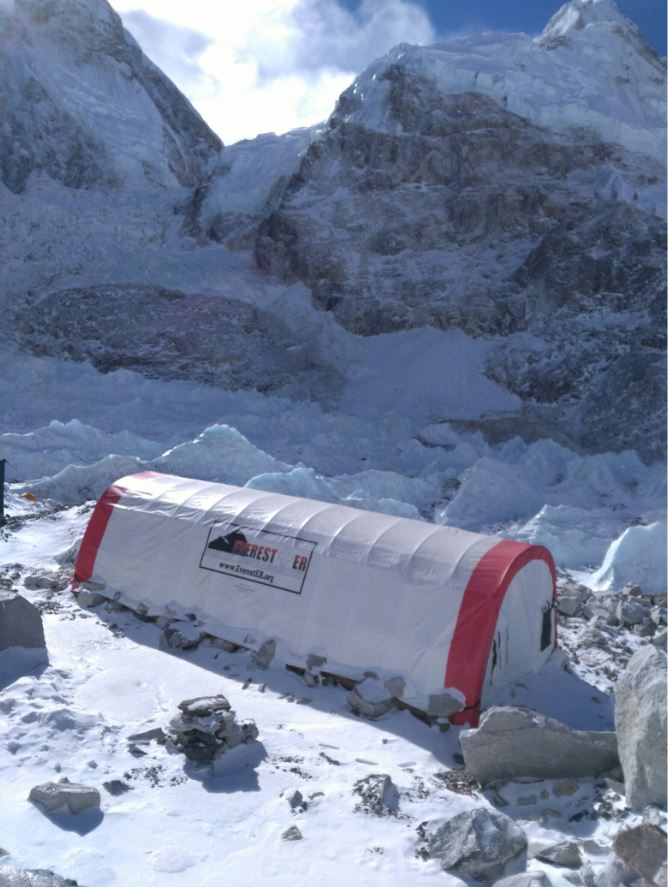Episode 4.2: Eat, Pray, Climb
By: Dr Deonarain
Base Camp is an ant farm. Bodies move from tent to tent. Hollers in Sherpa, Nepali, and English can be heard all around. Mountain gear is shifted with metal clangs. The whole village is animated. We are approaching the first rotation on Everest. Climbing teams practice ice skills in the low glacier and try the ropes and ladders of the Khumbu. They go up and down, up and down, teasingly testing their exertion at altitude.
Everest cannot be climbed without being acclimatised. At almost 9km above sea level, the oxygen at the peak has so little pressure that the lungs cannot extract enough to feed a human’s vital organs and tissues—unless, a lengthy acclimatisation has occurred.
Further, there are other hefty demands on the body. The cold, dryness, solar radiation—all batter the body in this less than hospitable environment. Through this, the importance of eating—lots—cannot be undervalued. Caloric consumption is double or more at altitude and this is largely just to keep the engines firing. The body is in a catabolic state from the cold and elevation that it must fight continuously against. The climbers will routinely consume 5,000 to 10,000 calories of food per day during their active periods if able (ironically, altitude tends to depress appetite). At rest, even as a base camp doctor, I find myself stepping up my intake as well, just to stay ‘in the black’—sometimes with great effort. Thankfully, Pasang, our cook is a master. Meals are varied and tasty, far beyond what you might assume you would get at a field camp at Everest. Of course, we are often served the Nepali staple, dhal bhat (dhal and rice), but this is the perfect cold weather food. It consists of a steaming fragrant mound of jasmine rice paired with a thick lentil broth, curried vegetables, and if we are lucky, braised seasoned meat. For other meals, we are treated to lasagna, pizza, pasta, sizzling yak steak… We eat as if our lives depend on it… in some ways, it does.
On April 18, the ant farm comes to a standstill. There is no climbing. Even preparations for the climb are put on hold. This is the day that the 2014 tragedy that killed 16 Sherpa when a serac fell onto the icefield is commemorated. It is time to pray.
Each climbing team will host a puja. It is a Buddhist religious blessing led by a local Llama and a chorus of drummers and chanters there to bring good fortunes and blessings on the climbers and people of camp. In the ceremony, offerings of rice, ghee, and buckwheat are made. Juniper branches are smoked and further offerings of food are placed on the stone ceremonial pillar, or chorten. At the climax of the ceremony the participants are smeared with buckwheat flour and adorned with a white silk scarf, or kada from the Llama. A bounty of food is passed around—fried twisted breads, stone-heavy cake, chocolates and other sweets. Next comes the ‘chang’—fermented rice water, strong enough to floor a yak. If you remain standing, you are brought into the circle of linked arms and bodies around the drummers and are taught the Sherpa dances—heavy foot stomping dances with tribal and ancient rhythms. Each step takes you back a century… Before the culmination of the prayers, brightly coloured prayer flags are spread in four directions. They are stretched until they reach the flags of next camp. In this way, every camp of Everest is connected. Aligned with the spiritual beliefs of the Sherpa, we are all, literally, connected.
When the praying and dancing is finished, the crowd disperses. The ant colony comes alive again. The first rotation is about to begin. It’s time to climb.
Devouring cake on my birthday
Prayers and offerings at the puja
Climbers depart up the Khumbu in the still of night

Dr Dinesh Deonarain is a Fellow of the Royal New Zealand College of Urgent Care who is in Nepal on assignment. He is volunteering for the Himalayan Rescue Association as one of the Everest ER base camp doctors for the 2019 climbing season. This blog follows his experiences in the high alpine of the Everest region.
Listen to the Profile in Urgent Care podcast with Dr Dinesh Deonarain.
If you would like to support Everest ER and the Himalayan Rescue Association, you can donate by bank transfer to: BNZ 02-0800-0196128-000. Also, you can follow Everest ER this season at www.EverestER.org
Boots on Everest – Episode 1
Boots on Everest – Episode 2
Boots on Everest – Episode 3 – Part 1
Boots on Everest – Episode 3 – Part 2
Boots on Everest – Episode 3 – Part 3
Boots on Everest – Episode 4 – Part 1
